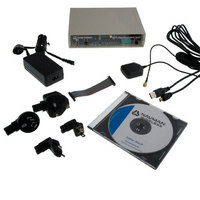AA003053-G Navman Wireless, AA003053-G Datasheet - Page 8

AA003053-G
Manufacturer Part Number
AA003053-G
Description
DEV KIT FOR JUPITER 30XLP
Manufacturer
Navman Wireless
Type
Receiver, GPSr
Specifications of AA003053-G
Frequency
1575.42MHz
For Use With/related Products
Jupiter 30XLP
Lead Free Status / RoHS Status
Lead free / RoHS Compliant
Other names
943-1000
For further information refer to the Navman Low Power Operating Modes application note
(LA000513), Navman NMEA reference manual (MN000315) and the SiRF Binary Protocol
reference manual.
3.5 Differential aiding
3.6 Core processor performance
The standard Jupiter 30 xLP with GSW3 software runs at a CPU clock speed of 49 MHz.
An SDK (Software Development Kit) is available from SiRF to customise the Jupiter 30 xLP
firmware.
3.7 Sensitivity
Sensitivity of the Jupiter 30 xLP is measured assuming a system noise value of 3 dB. The
sensitivity values are as follows:
3.8 Dynamic constraints
The Jupiter 30 xLP receiver is programmed to deliberately lose track if any of the following limits
is exceeded:
LA000576D © 2008 Navman Wireless OEM Solutions. All rights reserved. Proprietary information and specifications subject to change without notice.
3.4.2 Push-To-Fix mode
Push-To-Fix mode always forces the GPS software to revert to a continuous sleep mode
after a navigation position fix. It will stay in sleep mode until woken by activation of the
WAKEUP input (pad 26) to compute a fresh position.
If the ephemeris data become invalid, the RTC has the ability to self activate and refresh the
data, thus keeping the restart TTFF very short.
This mode yields the lowest power consumption of the module, and is ideal where a battery
powered application requires very few position fixes.
3.5.1 Differential GPS (DGPS)
DGPS is not available on the Jupiter 30 xLP.
3.5.2 Satellite Based Augmentation Systems (SBAS)
The Jupiter 30 xLP is capable of receiving SBAS differential corrections including WAAS
and EGNOS. SBAS improves horizontal position accuracy by correcting GPS signal errors
caused by ionospheric disturbances, timing and satellite orbit errors.
velocity: 500 m/s max
acceleration: 4 G (39.2 m/s
vehicle jerk: 5 m/s
altitude: 18 000 m max (referenced to MSL)
acquisition – cold start
acquisition – hot start
navigation
tracking
3
max
Parameter
2
) max
Table 3-2: Sensitivity
Signal strength
–144 dBm
–155 dBm
–157 dBm
–159 dBm
26 dBHz
15 dBHz
13 dBHz
10 dBHz
C/N
0























